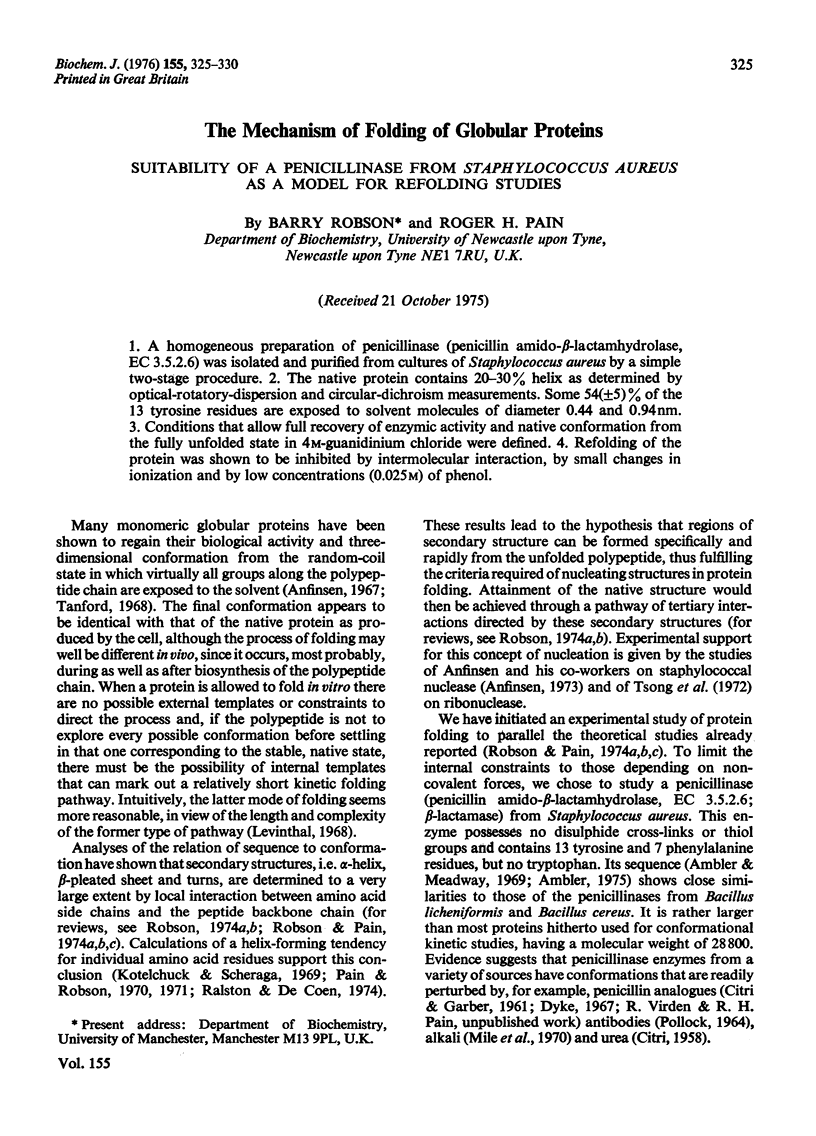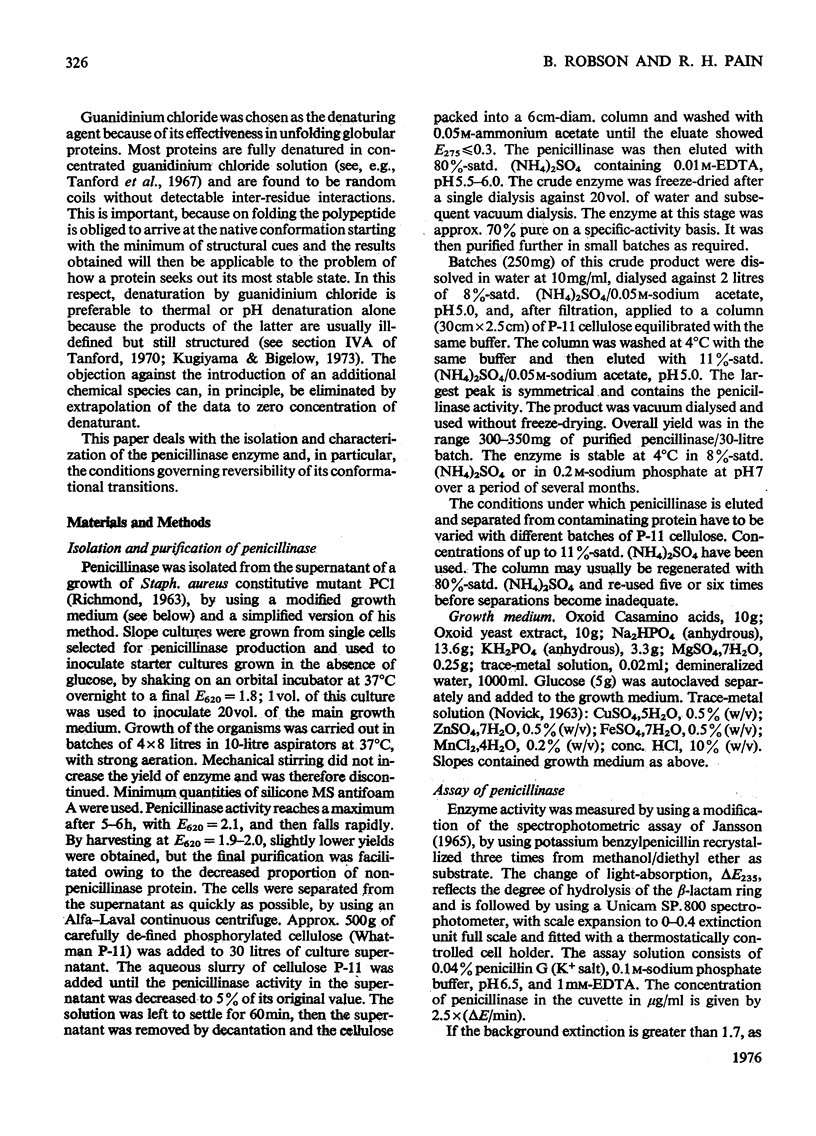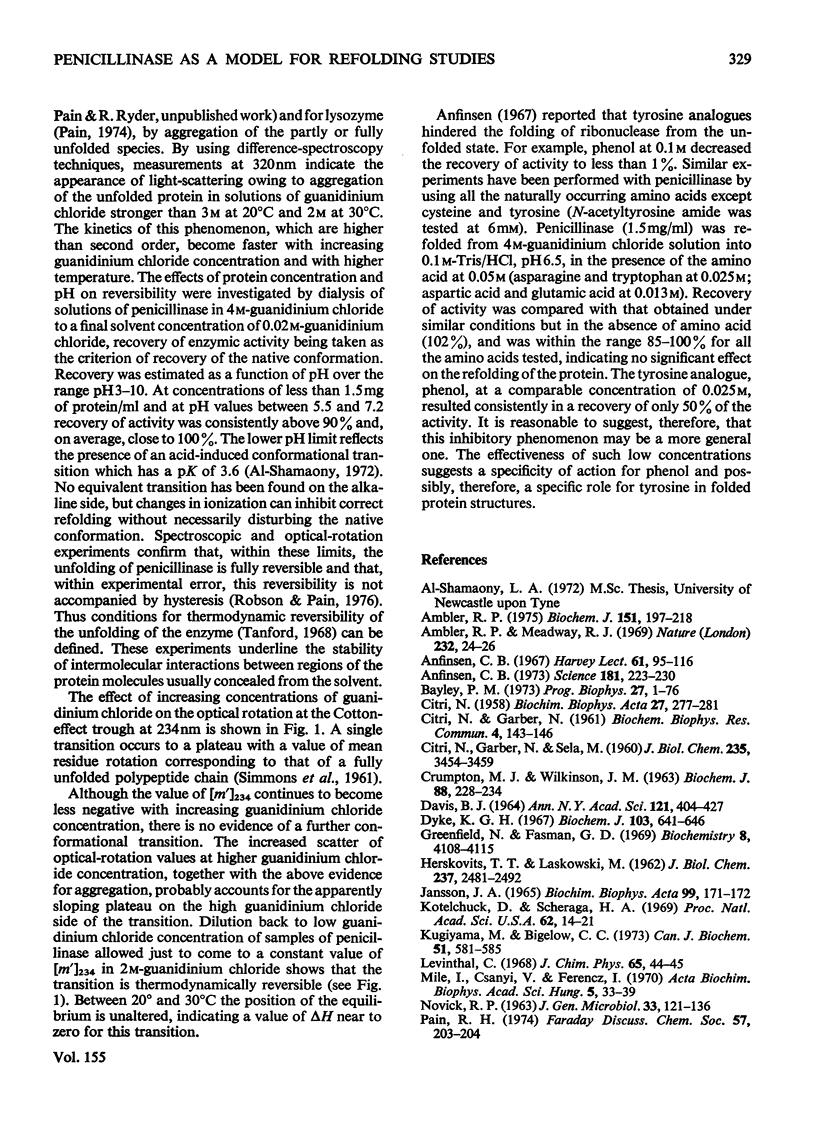Abstract
1. A homogeneous preparation of penicillinase (penicillin amido-beta-lactamhydrolase, EC 3.5.2.6) was isolated and purified from cultures of Staphylococcus aureus by a simple two-stage procedure. 2. The native protein contains 20-30% helix as determined by optical-rotatory-dispersion and circular-dichroism measurements. Some 54(+/-5)% of the 13 tyrosine residues are exposed to solvent molecules of diameter 0.44 and 0.94 nm. 3. Conditions that allow full recovery of enzymic activity and native conformation from the fully unfolded state in 4M-guanidinium chloride were defined. 4. Refolding of the protein was shown to be inhibited by intermolecular interaction, by small changes in ionization and by low concentrations (0.025 M) of phenol.
Full text
PDF





Selected References
These references are in PubMed. This may not be the complete list of references from this article.
- Ambler R. P., Meadway R. J. Chemical structure of bacterial penicillinases. Nature. 1969 Apr 5;222(5188):24–26. doi: 10.1038/222024a0. [DOI] [PubMed] [Google Scholar]
- Ambler R. P. The amino acid sequence of Staphylococcus aureus penicillinase. Biochem J. 1975 Nov;151(2):197–218. doi: 10.1042/bj1510197. [DOI] [PMC free article] [PubMed] [Google Scholar]
- Anfinsen C. B. Principles that govern the folding of protein chains. Science. 1973 Jul 20;181(4096):223–230. doi: 10.1126/science.181.4096.223. [DOI] [PubMed] [Google Scholar]
- Anfinsen C. B. The formation of the tertiary structure of proteins. Harvey Lect. 1967;61:95–116. [PubMed] [Google Scholar]
- CITRI N., GARBER N. Evidence for a change in the active site of penicillinase caused by a competitive inhibitor. Biochem Biophys Res Commun. 1961 Feb 24;4:143–146. doi: 10.1016/0006-291x(61)90364-3. [DOI] [PubMed] [Google Scholar]
- CITRI N., GARBER N., SELA M. The effect of urea and guanidine hydrochloride on activity and optical rotation of penicillinase. J Biol Chem. 1960 Dec;235:3454–3459. [PubMed] [Google Scholar]
- CITRI N. Two antigenically different states of active penicillinase. Biochim Biophys Acta. 1958 Feb;27(2):277–281. doi: 10.1016/0006-3002(58)90334-2. [DOI] [PubMed] [Google Scholar]
- CRUMPTON M. J., WILKINSON J. M. AMINO ACID COMPOSITIONS OF HUMAN AND RABBIT GAMMA-GLOBULINS AND OF THE FRAGMENTS PRODUCED BY REDUCTION. Biochem J. 1963 Aug;88:228–234. doi: 10.1042/bj0880228. [DOI] [PMC free article] [PubMed] [Google Scholar]
- DAVIS B. J. DISC ELECTROPHORESIS. II. METHOD AND APPLICATION TO HUMAN SERUM PROTEINS. Ann N Y Acad Sci. 1964 Dec 28;121:404–427. doi: 10.1111/j.1749-6632.1964.tb14213.x. [DOI] [PubMed] [Google Scholar]
- Dyke K. G. Substrate-specific inactivation of staphylococcal penicillinase. Biochem J. 1967 Jun;103(3):641–646. doi: 10.1042/bj1030641. [DOI] [PMC free article] [PubMed] [Google Scholar]
- Greenfield N., Fasman G. D. Computed circular dichroism spectra for the evaluation of protein conformation. Biochemistry. 1969 Oct;8(10):4108–4116. doi: 10.1021/bi00838a031. [DOI] [PubMed] [Google Scholar]
- HERSKOVITS T. T., LASKOWSKI M., Jr Location of chromophoric residues in proteins by solvent perturbation. I. Tyrosyls in serum albumins. J Biol Chem. 1962 Aug;237:2481–2492. [PubMed] [Google Scholar]
- JANSSON J. A. A DIRECT SPECTROPHOTOMETRIC ASSAY FOR PENICILLIN BETA-LACTAMASE (PENICILLINASE). Biochim Biophys Acta. 1965 Apr 26;99:171–172. doi: 10.1016/s0926-6593(65)80018-2. [DOI] [PubMed] [Google Scholar]
- Kotelchuck D., Scheraga H. A. The influence of short-range interactions on protein onformation. II. A model for predicting the alpha-helical regions of proteins. Proc Natl Acad Sci U S A. 1969 Jan;62(1):14–21. doi: 10.1073/pnas.62.1.14. [DOI] [PMC free article] [PubMed] [Google Scholar]
- Kugimiya M., Bigelow C. C. The denatured states of lysozyme. Can J Biochem. 1973 May;51(5):581–585. doi: 10.1139/o73-072. [DOI] [PubMed] [Google Scholar]
- Mile I., Csányi V., Ferencz I. Reversible change in iodine sensitivity of penicillinase by alkali treatment. Acta Biochim Biophys Acad Sci Hung. 1970;5(1):33–39. [PubMed] [Google Scholar]
- NOVICK R. P. ANALYSIS BY TRANSDUCTION OF MUTATIONS AFFECTING PENICILLINASE FORMATION IN STAPHYLOCOCCUS AUREUS. J Gen Microbiol. 1963 Oct;33:121–136. doi: 10.1099/00221287-33-1-121. [DOI] [PubMed] [Google Scholar]
- POLLOCK M. R. STIMULATING AND INHIBITING ANTIBODIES FOR BACTERIAL PENICILLINASE. Immunology. 1964 Nov;7:707–723. [PMC free article] [PubMed] [Google Scholar]
- POLLOCK M. R., TORRIANI A. M. Purification et caractéristiques physicochimiques de la pénicillinase de Bacillus cereus. C R Hebd Seances Acad Sci. 1953 Jul 20;237(3):276–278. [PubMed] [Google Scholar]
- Pain R. H., Robson B. Analysis of the code relating sequence to secondary structure in proteins. Nature. 1970 Jul 4;227(5253):62–63. doi: 10.1038/227062a0. [DOI] [PubMed] [Google Scholar]
- RICHMOND M. H. PURIFICATION AND PROPERTIES OF THE EXOPENICILLINASE FROM STAPHYLOCOCCUS AUREUS. Biochem J. 1963 Sep;88:452–459. doi: 10.1042/bj0880452. [DOI] [PMC free article] [PubMed] [Google Scholar]
- Ralston E., De Coen J. L. Folding of polypeptide chains induced by the amino acid side-chains. J Mol Biol. 1974 Mar;83(3):393–420. doi: 10.1016/0022-2836(74)90287-3. [DOI] [PubMed] [Google Scholar]
- Robson B., Pain R. H. Analysis of the code relating sequence to conformation in globular proteins. An informational analysis of the role of the residue in determining the conformation of its neighbours in the primary sequence. Biochem J. 1974 Sep;141(3):883–897. doi: 10.1042/bj1410883. [DOI] [PMC free article] [PubMed] [Google Scholar]
- Robson B., Pain R. H. Analysis of the code relating sequence to conformation in globular proteins. Development of a stereochemical alphabet on the basis of intra-residue information. Biochem J. 1974 Sep;141(3):869–882. doi: 10.1042/bj1410869. [DOI] [PMC free article] [PubMed] [Google Scholar]
- Robson B., Pain R. H. Analysis of the code relating sequence to conformation in globular proteins. The distribution of residue pairs in turns and kinks in the backbone chain. Biochem J. 1974 Sep;141(3):899–904. doi: 10.1042/bj1410899. [DOI] [PMC free article] [PubMed] [Google Scholar]
- Robson B., Pain R. H. The mechanism of folding of globular proteins. Equilibria and kinetics of conformational transitions of penicillinase from Staphylococcus aureus involving a state of intermediate conformation. Biochem J. 1976 May 1;155(2):331–344. doi: 10.1042/bj1550331. [DOI] [PMC free article] [PubMed] [Google Scholar]
- Tanford C. Protein denaturation. C. Theoretical models for the mechanism of denaturation. Adv Protein Chem. 1970;24:1–95. [PubMed] [Google Scholar]
- Tsong T. Y., Baldwin R. L. A sequential model of nucleation-dependent protein folding: kinetic studies of ribonuclease A. J Mol Biol. 1972 Feb 14;63(3):453–469. doi: 10.1016/0022-2836(72)90440-8. [DOI] [PubMed] [Google Scholar]
- URNES P., DOTY P. Optical rotation and the conformation of polypeptides and proteins. Adv Protein Chem. 1961;16:401–544. doi: 10.1016/s0065-3233(08)60033-9. [DOI] [PubMed] [Google Scholar]
- Waley S. G. A spectrophotometric assay of beta-lactamase action on penicillins. Biochem J. 1974 Jun;139(3):789–790. doi: 10.1042/bj1390789. [DOI] [PMC free article] [PubMed] [Google Scholar]


